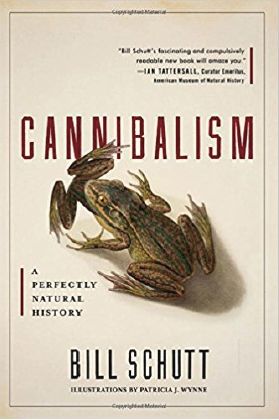|
<BOOK REVIEW>
Cannibalism: A Perfectly Natural History By Bill Schutt Chapel Hill, NC: Algonquin Books, 332 pp. ISBN: 978-1-61620-462-4, 2017. $26.95 (USA), paperback
William C. McGrew
School of Psychology & Neuroscience, University of St Andrews, Scotland, UK 
Given that chimpanzees have shown more instances of cannibalism than all other species of non-human primates combined, and also that chimpanzees are the most-invoked species for modelling the evolutionary origins of human behaviour, this book seemed worth scrutinising. Furthermore, the sub-title suggests a natural science viewpoint, rather than the more usual social science (i.e., anthropology) viewpoint, as does the author’s status as a vertebrate zoologist (on the faculty of Long Island University, USA). For comparative contrast, see what may be the best previous example of tackling the topic, Petrinovich’s (2000) The Cannibal Within, in which nonhuman cannibalism gets only 5 pp. First, the structure and format. Schutt does not do research on cannibalism but instead summarises and synthesises findings on the topic. But he goes beyond reading and analysing published material by travelling to interview researchers in situ, with participant observation that entails (e.g.) archaeology and anthropophagy. (Yes, he eats human tissue.) About this, he writes accessibly but academically (e.g., providing scientific names for taxa), with a light touch enlivened by humour. Good points are: 28 pages of endnotes by text page number, which provide references to publications; an extensive book list (n = 68), of which a third focus on cannibalism; 35 line drawings as illustrations (although almost all lack captions). Not so good is the inexplicable lack of an index. The result is award-winning, and the content usefully extends and updates Petrinovich’s older efforts. What are the book’s strong points? His is the most comprehensive, available treatment of cannibalism in terms of variation across animal taxa, from invertebrates (cricket, mantis, spider, snail) to vertebrates (spadefoot toad, hamster, polar bear, caecilian, dinosaur). Some of this amounts to myth-busting. Among extinct hominins, he concentrates on Neanderthals, as they provide the best data. But in all cases, he focusses healthy scepticism on exaggerated claims, showing how hard it is methodologically to ascertain cannibalism unless observed directly. He covers the standard sub-categories of types, that is, survival, ritual, nutritional, endo-, exo-, etc., but usefully adds others that are less well-known, such as filial, medical, auto-, etc. Schutt includes the standard case studies: New Guinean mortuary cannibalism by the Fore and the resulting disease of kuru, Donner Party (American settlers snowbound and starving), Christian Eucharist, etc. In each case, he is able to go beyond Petrinovich, showing that research continues to yield new insights. But he shies away from the Aztecs, adopting an anti-conquistadore, pro-native American stance that is almost polemical. He details other cases, e.g., WWII Stalingrad, 20th century China, and European medical anthropophagy that surprisingly flourished and endured until recently. His coverage of present-day, fashionable placentophagia in the West is entertaining. What about weak points? The shadow of William Arens hangs over the book, long after his sell-by date. (Arens wrote a provocative book, The Man-Eating Myth, almost 40 years ago that claimed that human cannibalism did not exist.) Although he was quickly debunked, somehow his influence persists, and Schutt spends far too much time in musing conversations with Arens, who tries to weasel out of the facts. Especially regretable in Schutt’s ignoring of Anasazi cannibalism in the American Southwest, which is well-documented archaeologically. At times, he wanders off-topic, such as telling us more than we need to know about prions versus viruses. Some of his forays into the arts come across as a bit trivial (Odysseus, Robinson Crusoe), while other obvious candidates are ignored, such as a recent, long-running American television series, ‘Dexter’, which features an anthropophagic forensic technician. But what about non-human primates? Disappointingly, although chimpanzees get most of the mentions, all but one 3-page section are superficial, and in it, only three sources are cited: Hiraiwa-Hasegawa (1992) (also used by Petrinovich), Goodall (1977), and a popular reference to Townsend et al. (2007). This will disappoint readers of PAN, considering all that has been published between Bygott (1972) and Nishie & Nakamura (2018). All of these papers focus on infanticide, while Schutt seems unaware of (e.g.) consumption of adults in other primate taxa (Hamalainer 2012) or non-infanticidal consumption (Dellatore et al. 2009). So, a panthropologist will learn nothing about primate cannibalism, but the book will put it into comparative perspective, especially if read sequentially after Petrinovich. REFERENCES Arens W 1979. The Man-Eating Myth. Oxford University Press, Oxford. Bygott JD 1972. Cannibalism among wild chimpanzees. Nature 238:410–411. https://doi.org/10.1038/238410a0 Dellatore DF 2009. Two cases of mother-infant cannibalism in orangutans. Primates 50:277–281. https://doi.org/10.1007/s10329-009-0142-5 Goodall J 1977. Infant killing and cannibalism in free-living chimpanzees. Folia Primatol 28:259–282. https://doi.org/10.1159/000155817 Hamalainer A 2012. A case of adult cannibalism in the gray mouse lemur, Microcebus murinus. Am J Primatol 74:783–787. https://doi.org/10.1002/ajp.22034 Hiraiwa-Hasegawa M 1992. Cannibalism among non-human primates. In: Cannibalism: Ecology and Evolution among Diverse Taxa. Elgar M, Crespi B (eds), Oxford University Press, New York, pp. 323–338. Nishie H, Nakamura M 2018. A newborn infant chimpanzee snatched and cannibalized immediately after birth: Implications for “maternity leave” in wild chimpanzee. Am J Phys Anthropol 165:194–199. https://doi.org/10.1002/ajpa.23327 Petrinovich L 2000. The Cannibal Within. Aldine de Gruyter, New York. Townsend SW, Slocombe KE, Thompson ME, Zuberbühler K 2007. Female-led infanticide in wild chimpanzees. Curr Biol 17:R355–R356. https://doi.org/10.1016/j.cub.2007.03.020 Back to Contents |